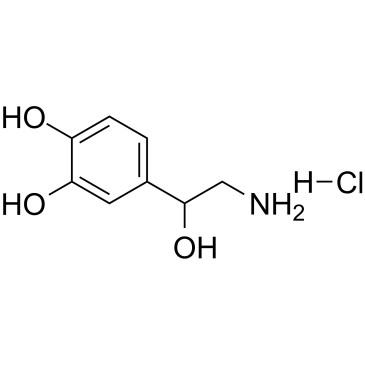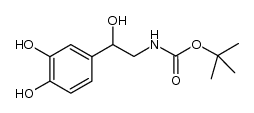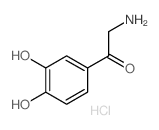DL-Norepinephrine hydrochloride

DL-Norepinephrine hydrochloride structure
|
Common Name | DL-Norepinephrine hydrochloride | ||
|---|---|---|---|---|
| CAS Number | 55-27-6 | Molecular Weight | 205.639 | |
| Density | 1.397g/cm3 | Boiling Point | 442.6ºC at 760mmHg | |
| Molecular Formula | C8H12ClNO3 | Melting Point | 140-144ºC (dec.) | |
| MSDS | USA | Flash Point | 221.5ºC | |
| Symbol |

GHS06 |
Signal Word | Danger | |
Use of DL-Norepinephrine hydrochlorideDL-Norepinephrine hydrochloride is a synthetic phenylethylamine that mimics the sympathomimetic actions of the endogenous norepinephrine.DL-Norepinephrine hydrochloride is a neurotransmitter targets α1 and β1 adrenoceptors, has an increasing effect on subendocardial oxygen tension[1]. |
| Name | dl-noradrenaline hydrochloride |
|---|---|
| Synonym | More Synonyms |
| Description | DL-Norepinephrine hydrochloride is a synthetic phenylethylamine that mimics the sympathomimetic actions of the endogenous norepinephrine.DL-Norepinephrine hydrochloride is a neurotransmitter targets α1 and β1 adrenoceptors, has an increasing effect on subendocardial oxygen tension[1]. |
|---|---|
| Related Catalog | |
| Target |
IC50: α1 adrenoceptor and β1 adrenoceptor[1] |
| References |
| Density | 1.397g/cm3 |
|---|---|
| Boiling Point | 442.6ºC at 760mmHg |
| Melting Point | 140-144ºC (dec.) |
| Molecular Formula | C8H12ClNO3 |
| Molecular Weight | 205.639 |
| Flash Point | 221.5ºC |
| Exact Mass | 205.050568 |
| PSA | 86.71000 |
| LogP | 1.59220 |
| Appearance of Characters | crystalline | off-white to tan |
| InChIKey | FQTFHMSZCSUVEU-UHFFFAOYSA-N |
| SMILES | Cl.NCC(O)c1ccc(O)c(O)c1 |
| Storage condition | 2-8°C |
Synonym: Section 2 - COMPOSITION, INFORMATION ON INGREDIENTS
Risk Phrases: None Listed. Section 3 - HAZARDS IDENTIFICATION EMERGENCY OVERVIEW
The toxicological properties of this material have not been fully investigated. Potential Health Effects Eye: May cause eye irritation. The toxicological properties of this material have not been fully investigated. Skin: May cause skin irritation. The toxicological properties of this material have not been fully investigated. Ingestion: May cause gastrointestinal irritation with nausea, vomiting and diarrhea. The toxicological properties of this substance have not been fully investigated. Inhalation: The toxicological properties of this substance have not been fully investigated. Inhalation of dust may cause respiratory tract irritation. Chronic: No information found. Section 4 - FIRST AID MEASURES Eyes: Flush eyes with plenty of water for at least 15 minutes, occasionally lifting the upper and lower eyelids. Get medical aid immediately. Skin: Get medical aid. Flush skin with plenty of water for at least 15 minutes while removing contaminated clothing and shoes. Wash clothing before reuse. Ingestion: If victim is conscious and alert, give 2-4 cupfuls of milk or water. Never give anything by mouth to an unconscious person. Get medical aid immediately. Inhalation: Remove from exposure and move to fresh air immediately. If not breathing, give artificial respiration. If breathing is difficult, give oxygen. Get medical aid. Notes to Physician: Section 5 - FIRE FIGHTING MEASURES General Information: As in any fire, wear a self-contained breathing apparatus in pressure-demand, MSHA/NIOSH (approved or equivalent), and full protective gear. During a fire, irritating and highly toxic gases may be generated by thermal decomposition or combustion. Extinguishing Media: Use agent most appropriate to extinguish fire. Use water spray, dry chemical, carbon dioxide, or appropriate foam. Section 6 - ACCIDENTAL RELEASE MEASURES General Information: Use proper personal protective equipment as indicated in Section 8. Spills/Leaks: Clean up spills immediately, observing precautions in the Protective Equipment section. Sweep up or absorb material, then place into a suitable clean, dry, closed container for disposal. Avoid generating dusty conditions. Provide ventilation. Section 7 - HANDLING and STORAGE Handling: Wash thoroughly after handling. Use only in a well-ventilated area. Minimize dust generation and accumulation. Avoid contact with eyes, skin, and clothing. Keep container tightly closed. Avoid ingestion and inhalation. Storage: Store in a tightly closed container. Store in a cool, dry, well-ventilated area away from incompatible substances. Section 8 - EXPOSURE CONTROLS, PERSONAL PROTECTION Engineering Controls: Use adequate ventilation to keep airborne concentrations low. Exposure Limits CAS# 55-27-6: Personal Protective Equipment Eyes: Wear appropriate protective eyeglasses or chemical safety goggles as described by OSHA's eye and face protection regulations in 29 CFR 1910.133 or European Standard EN166. Skin: Wear appropriate protective gloves to prevent skin exposure. Clothing: Wear appropriate protective clothing to prevent skin exposure. Respirators: Follow the OSHA respirator regulations found in 29 CFR 1910.134 or European Standard EN 149. Use a NIOSH/MSHA or European Standard EN 149 approved respirator if exposure limits are exceeded or if irritation or other symptoms are experienced. Section 9 - PHYSICAL AND CHEMICAL PROPERTIES Physical State: Powder Color: beige Odor: Not available. pH: Not available. Vapor Pressure: Not available. Viscosity: Not available. Boiling Point: Not available. Freezing/Melting Point: 145.00 - 147.00 deg C Autoignition Temperature: Not available. Flash Point: Not available. Explosion Limits, lower: Not available. Explosion Limits, upper: Not available. Decomposition Temperature: Solubility in water: Specific Gravity/Density: Molecular Formula: C8H11NO3.HCl Molecular Weight: 205.64 Section 10 - STABILITY AND REACTIVITY Chemical Stability: Stability unknown. Conditions to Avoid: Incompatible materials. Incompatibilities with Other Materials: Oxidizing agents. Hazardous Decomposition Products: Hydrogen chloride, nitrogen oxides, carbon monoxide, carbon dioxide. Hazardous Polymerization: Has not been reported Section 11 - TOXICOLOGICAL INFORMATION RTECS#: CAS# 55-27-6: DN6650000 LD50/LC50: Not available. Carcinogenicity: DL-Norepinephrine Hydrochloride - Not listed by ACGIH, IARC, or NTP. Other: See actual entry in RTECS for complete information. Section 12 - ECOLOGICAL INFORMATION Section 13 - DISPOSAL CONSIDERATIONS Dispose of in a manner consistent with federal, state, and local regulations. Section 14 - TRANSPORT INFORMATION IATA Shipping Name: ALKALOID SALTS, SOLID, N.O.S.* Hazard Class: 6.1 UN Number: 1544 Packing Group: III IMO Shipping Name: ALKALOIDS, SOLID, N.O.S. Hazard Class: 6.1 UN Number: 1544 Packing Group: III RID/ADR Shipping Name: ALKALOID SALTS, SOLID, N.O.S. Hazard Class: 6.1 UN Number: 1544 Packing group: III Section 15 - REGULATORY INFORMATION European/International Regulations European Labeling in Accordance with EC Directives Hazard Symbols: Not available. Risk Phrases: Safety Phrases: S 26 In case of contact with eyes, rinse immediately with plenty of water and seek medical advice. S 28A After contact with skin, wash immediately with plenty of water. S 37 Wear suitable gloves. S 45 In case of accident or if you feel unwell, seek medical advice immediately (show the label where possible). WGK (Water Danger/Protection) CAS# 55-27-6: No information available. Canada None of the chemicals in this product are listed on the DSL/NDSL list. CAS# 55-27-6 is not listed on Canada's Ingredient Disclosure List. US FEDERAL TSCA CAS# 55-27-6 is not listed on the TSCA inventory. It is for research and development use only. SECTION 16 - ADDITIONAL INFORMATION N/A |
CHEMICAL IDENTIFICATION
HEALTH HAZARD DATAACUTE TOXICITY DATA
|
| Symbol |

GHS06 |
|---|---|
| Signal Word | Danger |
| Hazard Statements | H301 |
| Precautionary Statements | P301 + P310 |
| Personal Protective Equipment | Eyeshields;Faceshields;Gloves;type P2 (EN 143) respirator cartridges |
| Hazard Codes | T |
| Risk Phrases | R25 |
| Safety Phrases | 36/37/39-45 |
| RIDADR | UN 2811 |
| WGK Germany | 3 |
| RTECS | DN6650000 |
| Packaging Group | III |
| Hazard Class | 6.1(b) |
| HS Code | 2922509090 |
|
~99% 
DL-Norepinephri... CAS#:55-27-6 |
| Literature: Bernini, Roberta; Crisante, Fernanda; Barontini, Maurizio; Fabrizi, Giancarlo Synthesis, 2009 , # 22 art. no. P09409SS, p. 3838 - 3842 |
|
~95% 
DL-Norepinephri... CAS#:55-27-6 |
| Literature: NEON LABORATORIES LTD.; DALVI, Mahesh Bhagoji; KENNY, Rajesh Shashikant; KAWLE, Ganesh Ramachandra Patent: WO2013/8247 A1, 2013 ; Location in patent: Page/Page column 10 ; |
| HS Code | 2922509090 |
|---|---|
| Summary | 2922509090. other amino-alcohol-phenols, amino-acid-phenols and other amino-compounds with oxygen function. VAT:17.0%. Tax rebate rate:13.0%. . MFN tariff:6.5%. General tariff:30.0% |
|
Sympathetic activity induced by naloxone-precipitated morphine withdrawal is blocked in genetically engineered mice lacking functional CRF1 receptor.
Toxicol. Appl. Pharmacol. 283(1) , 42-9, (2015) There is large body evidence indicating that stress can lead to cardiovascular disease. However, the exact brain areas and the mechanisms involved remain to be revealed. Here, we performed a series of... |
|
|
An assessment of norepinephrine mediated hypertrophy to apoptosis transition in cardiac cells: a signal for cell death.
Chem. Biol. Interact. 225 , 54-62, (2015) Heart is an organ which is under a constant work load that generates numerous stress responses. Heart failure is associated with increased plasma norepinephrine (NE) and hypertrophic cell death. Withi... |
|
|
Relationship between noradrenaline release in the locus coeruleus and antiallodynic efficacy of analgesics in rats with painful diabetic neuropathy.
Life Sci. 92(23) , 1138-44, (2013) In animal models of neuropathic pain, the noradrenergic descending pain inhibitory pathways from the locus coeruleus (LC) may be suppressed. However, no study has investigated the correlation between ... |
| NA hydrochloride |
| DL-NOREPINEPHRINE HCL |
| DL-NORADRENALIN HYDROCHLORIDE |
| UNII:7W3827X38V |
| Arterenol hydrochloride |
| EINECS 200-229-8 |
| MFCD00012880 |
| 4-(2-Amino-1-hydroxyethyl)-1,2-benzenediol hydrochloride (1:1) |
| DL-Norepinephrine hydrochloride |
| 1,2-Benzenediol, 4-(2-amino-1-hydroxyethyl)-, hydrochloride (1:1) |
| (±)-4-(2-amino-1-hydroxyethyl)-1,2-Benzenediol hydrochloride |
| 4-(2-Amino-1-hydroxyethyl)benzene-1,2-diol hydrochloride (1:1) |
| DL-ARTERENOL HYDROCHLORIDE |
| DL-ARTERENOL |



